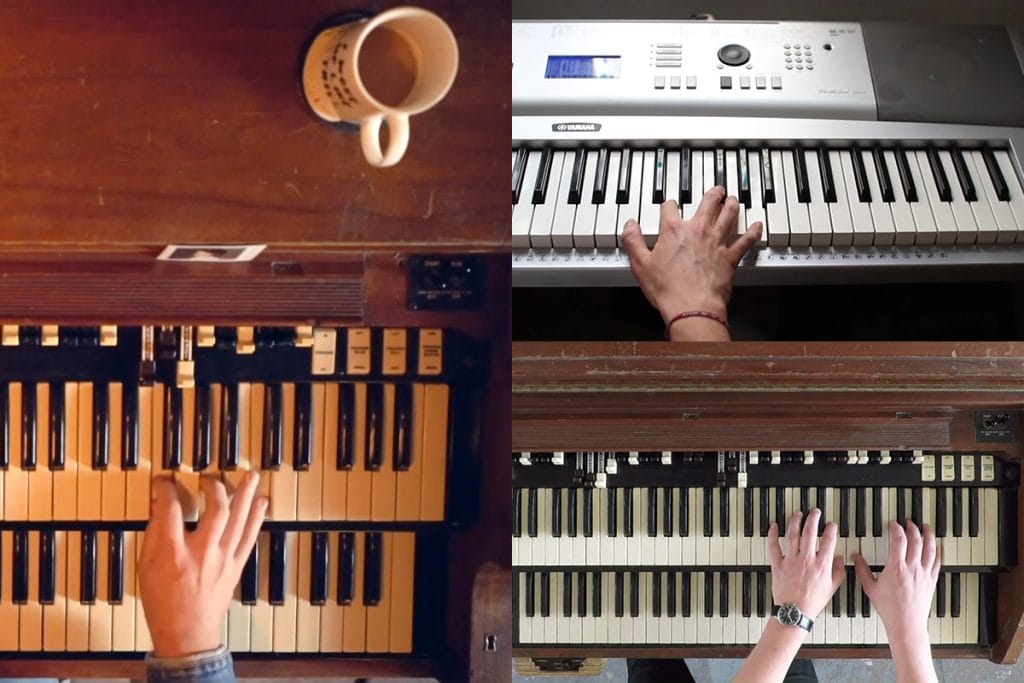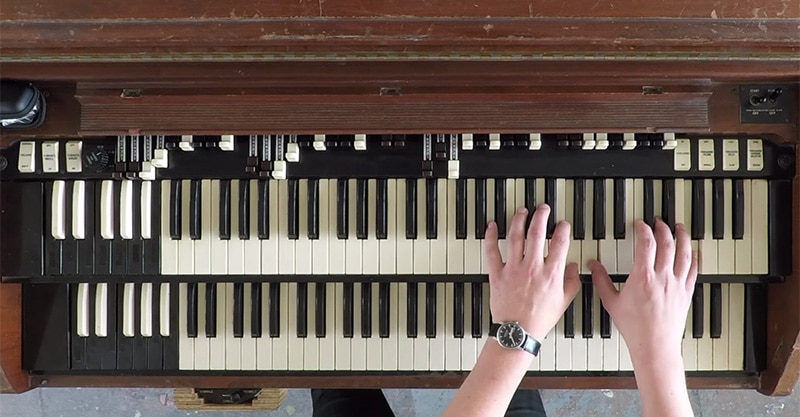
Are you learning to play the organ? Respect!
The organ shares plenty in common with the piano, meaning anything you can learn on the piano can easily transfer over to the organ and vice versa. Sure, there are some nuances to playing the organ that differ from the piano, but isn’t it nice to know that the two instruments have so much in common?
Well, if you’re ready to get excited about learning the organ, the best way to speed up your learning is by picking up your favorite songs. And in this guide, we look at over a dozen easy organ songs for beginners.
“Light My Fire” by The Doors
Song year: 1967
One of the rock bands that became iconic for their use of the organ in the 60s was The Doors, and one of their most recognizable tunes is surely “Light My Fire.”
Now, I’m certainly not going to suggest it’s the easiest song in the world to play, but it’s mostly white keys (except for that recurring F#) and it’s well worth learning. The video above even shows you how to play it at a slower tempo than the original.
“Like a Rolling Stone” by Bob Dylan
Song year: 1965
It’s hard to imagine a world where the legendary songwriter Bob Dylan stopped making music in the mid-60s. But that’s what would have happened if he hadn’t written “Like a Rolling Stone,” a song that made Dylan proud to be Dylan.
Before the song even had a title, Dylan ended up filling 10 to 20 pages with hatred- and revenge-charged lyrics. The many pages of words were eventually boiled down to four verses and a chorus, and “Like a Rolling Stone” was born.
The song is iconic for its inclusion of organ, which just so happens to be very straightforward, and very beginner friendly, with mostly single notes and double stops.
“Gimme Some Lovin’” by Spencer Davis Group
Song year: 1966
Rolling Stone put Spencer Davis Group’s “Gimme Some Lovin’” on its 500 Greatest Songs list, and I heartily agree. This blue-eyed soul / R&B classic has an upbeat, danceable groove, and a memorable melody.
The organ playing on “Gimme Some Lovin’” very much complements the feel of the song, and the main riff is a thing of legend.
While I’m not promising an easy ride with this tune, it’s a project well worth tackling for beginner organists.

“Yesterday” by The Beatles
Song year: 1965
Whatever you can play on the piano, you can basically play on the organ as well, and that goes for The Beatles’ “Yesterday” too.
The video above demonstrates how you can play the song with mostly two fingers at a time.
Of course, you can embellish to your heart’s content once you become a better organist, but it’s a good idea to start simple and build from there.
“96 Tears” by ? and the Mysterians
Song year: 1966
This 60s garage rock hit features an essential organ riff that every beginner should aspire to learn.
The song was written by Question Mark in 1962, and the song found success on a local level. It was then brought to radio director Bob Dell, and the song quickly became the most requested, finding an audience in Canada as well.
This song has been credited with getting the punk rock movement up and going, but its psych-rock inclinations are far more evident.
“A Whiter Shade of Pale” by Procol Harum
Song year: 1967
Procol Harum’s “A Whiter Shade of Pale” became one of the most successful singles ever to be released, and it has been covered well over 1,000 times.
The organ playing on “A Whiter Shade of Pale” is essential learning for every organist, as there are many worthwhile concepts you can apply to your playing.
As a beginner, you’ll want to take your time with the right-hand and left-hand parts, practicing separately until you feel more comfortable with them.

“Seven Nation Army” by The White Stripes
Song year: 2003
The White Stripes’ “Seven Nation Army” could have ended as little more than a groan-worthy passing trend. Even record executives felt songwriter Jack White could do better.
The song endured, however, becoming a bit of an enduring modern classic and a sports arena clap-along. Step into a music school, and you will probably hear someone trying to pound out the notes to “Seven Nation Army.”
This song serves as a good tutorial for simplistic rock riffs.
“Believer” by Imagine Dragons
Song year: 2017
The main thing Imagine Dragons figured out was how to blend minor melodies, huge-sounding percussion tracks, droning synths, and repetitive guitar riffs to carve out their niche in pop. “Believer” does nothing to build on this formula, but at least it’s consistent.
Whether played on the piano or the organ, “Believer” is relatively straightforward.
“Viva la Vida” by Coldplay
Song year: 2008
This 2008 Baroque pop tune took the world by storm, winning two Grammy Awards in the process.
With all its layers, you might assume Coldplay’s “Viva la Vida” to be a complicated song. But strip away the production elements, and you are left with a simple, recognizable melody and a handful of chords.
If you’re a Coldplay fan, you should certainly consider working your way through this tune.

“Faded” by Alan Walker
Song year: 2015
Norwegian singer Iselin Solheim provided vocals for Alan Walker’s “Faded,” a ballad disguised as an electro-house tune. Let’s face it – the tempo is slow, it opens with a lone piano, and the lyrical content is emotional – that’s the stuff ballads are made of. Even with the electronic elements.
As of 2023, the music video is the 14th most viewed on YouTube. It probably has more to do with the song than the visuals, because the video is just Walker walking through run-down buildings.
Either way, if you like the song, you’ll probably find it more than agreeable to play on the organ.
“Smells Like Teen Spirit” by Nirvana
Song year: 1991
Nirvana’s “teen spirit” anthem of 1991 signaled the end of an era and the start of a fresh one. Grunge was about to go mainstream, and there would be very little room left for 80s glam metal bands on the charts.
And with the introduction of grunge, it also became very trendy to talk about being a loser, an outcast, or a misfit. Think Beck’s “Loser,” Radiohead’s “Creep,” or Wheatus’ “Teenage Dirtbag.”
The song may seem like an unusual choice for the organ, but that can also be what makes it a fun one. Overall, it’s not too hard to play, either. Just watch out for those black keys.
“Green Onions” by Booker T. & The M.G.’s
Song year: 1962
Released as an instrumental in 1962, Booker T. & The M.G.’s “Green Onions” is one of the most recognizable instrumental rock pieces featuring an organ.
The 12-bar blues utilizing a Hammond M3 organ may sound like it was worked out in advance, but large sections of the song were improvised in the studio.
So far as difficulty is concerned, “Green Onions” is probably about intermediate, but it should make for a great long-term project if you’re open to it.

“Us and Them” by Pink Floyd
Song year: 1974
As one of the longest songs off The Dark Side of the Moon, “Us and Them” opens with a Hammond organ along with a couple of piano tracks.
The power ballad features a jazz-influenced chord progression and is mostly about the senselessness of war and other social justice issues.
For the most part, the song (at least on the organ) is made up of long, sustained chords. That makes it a relatively easy song to learn. That said, learning how to shift between the chords fluidly can take a bit of work.
“Highway Star” by Deep Purple
Song year: 1972
My dad had a compilation album of classic rock he’d purchased from Japan, and one of the first songs on the CD was Deep Purple’s “Highway Star,” which features Jon Lord’s masterful organ playing.
Trying to duplicate everything Lord accomplished with this song as a beginner organist will probably prove difficult if not possible. That said, the intro and verse parts are learnable and worthwhile, especially if you need to work on your staccato technique.
“Roundabout” by Yes
Song year: 1972
Written by Yes guitarist Steve Howe and singer Jon Anderson, the progressive rock tune “Roundabout” ended up a very groovy one. Reportedly, it was written as the band was traveling from Aberdeen to Glasgow, encountering many roundabouts along the way.
There isn’t any organ for longer stretches of the earlier part of the song, but as it progresses, there are more and more parts to be executed.
I’m certainly not promising an easy ride learning “Roundabout,” though if you want to work on your arpeggios, it’s a hard song to ignore.
“In-A-Gadda-Da-Vida” by Iron Butterfly
Song year: 1968
Iron Butterfly’s “In-A-Gadda-Da-Vida” is legendary and groundbreaking for several reasons – one, the song is over 17 minutes, two, it features a classic rock riff everyone should learn, three, it’s the only Iron Butterfly song to break into the top 40, and four, it heavily influenced heavy metal music to come.
“In-A-Gadda-Da-Vida” was apparently in the works since the early days of the band and turning it into an extended jam was an idea they’d arrived at relatively early too.
The arpeggios in the intro are anything but easy (though you could probably learn to play that segment one note at a time), but the main riff is something every beginner should be able to get under their fingers.
“Karn Evil 9” by Emerson, Lake & Palmer
Song year: 1973
With over 29 minutes of runtime, “Karn Evil 9” is Emerson, Lake & Palmer’s longest rock / classical fusion song.
That being the case, there is plenty to be learned from Keith Emerson’s masterful organ riffs – some are simpler than others.
But so far as rock songs featuring the organ is concerned, this one is legendary.
Best Organ Songs For Beginners, Final Thoughts
Start slow, start simply. Work on one hand, one note at a time. Begin with songs that primarily feature white keys. Follow these simple tips and you can’t go wrong. And if you want to challenge the harder passages, be our guest!